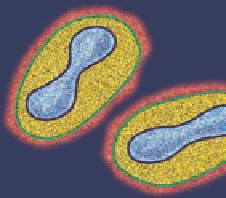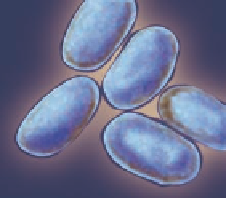Environmental Engineering Reference
In-Depth Information
Mortality
(if untreated)
Existence
of vaccine
Agent
Contagious
Symptoms
Treatment
Smallpox
(virus)
Yes
Fever, aches, headache, red
spots on face and torso
30%
Yes
Vaccination within 4 days after
exposure, IV hydration
Hemorrhagic
fever (viruses)
Yes
Vary but include fever,
bleeding, shock, and coma
Varies
No
Ebola has no cure; antiviral
riboflavin and some antibiotics
may help
Inhalation
anthrax
(bacterium)
No
Fever, chest pain, difficulty
breathing, respiratory failure
90-100%
Yes
Early treatment with Cipro and
other antibiotics
Botulism
(bacterium)
No
Blurred vision, progressive
paralysis, death within 24 hours
if not treated
60-100%
Yes
Equine antitoxin given early.
Intensive care, respirator
Pneumonic
plague
(bacterium)
Yes
High fever, chills, headache,
coughing blood, difficulty
breathing, respiratory failure
90-100%
No
Antibiotics
Tularemia
(bacterium)
No
Fever, sore throat, weakness,
respiratory stress, pneumonia
30-60%
Yes
(in testing)
Antibiotics
Smallpox
Botulism
Plague
Tularemia
Figure 14-8
Bioterrorist weapons:
characteristics of common agents that might be used by terrorists as
biological weapons.
Perhaps you are thinking, “Whoa, enough already.
This stuff is depressing and scary.” But it is a reality in
today's world. Let us look at some more hopeful news
about bioterrorism.
Early detection of biological agents is the key in
treating exposed victims and preventing the spread of
diseases to others. Some scientists are trapping com-
mon insects such as bees, beetles, moths, and crickets
to see whether they can be used as environmental
monitors of chemical and biological agents. Others are
trying to develop inexpensive and easy-to-use DNA
detectors to quickly and accurately diagnose any in-
fectious disease such as smallpox. For example, MIT
biologist Todd Rider has developed a biological sensor
that can detect dangerous biological agents such as an-
thrax within minutes. He made the sensor out of
mouse immune cells by inserting a gene for antibodies
to a particular biological agent (such as anthrax) along
with a gene that causes a jellyfish to glow. When a bio-
logical agent activates the antibody, the immune cells
of the mouse light up.
Treatments are available for the most common bi-
ological agents (Figure 14-8)—unless they have been
genetically modified to make such treatments fail.
Outbreaks can be kept under control if hospitals stock
large supplies of antibiotics and vaccines for treat-
ment of common diseases, provide emergency and
hospital workers with detection systems and protec-
tive gear, and alert doctors to the symptoms of the
most common biological warfare agents.
Critical think-
ing: what three things would you do to reduce the threat of
bioterriorism?
14-3
CHEMICAL HAZARDS
Science: Toxic and Hazardous Chemicals
Toxic chemicals can harm or kill, and hazardous
chemicals can cause various types of harm.
A
toxic chemical
can cause temporary or permanent
harm or death to humans or animals. A
hazardous
chemical
can harm humans or other animals because
it is flammable or explosive or because it can irritate or
damage the skin or lungs, interfere with oxygen up-
take, or induce allergic reactions.







